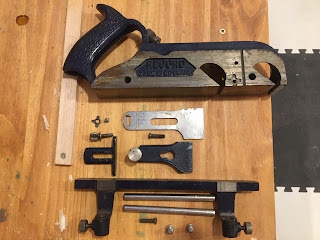To be clear from the start, I am not bashing on EBay, I bought a lot of tools from EBay and for me EBay is a great tool that allows all of us to open our horizon about vintage tools. Some day you can find some real steal, some days you may feel some regrets to get some too much expensive tools at auction, but all in all this is a good tool to find what you are looking for if you are a bit cautious.
But everybody can confess that Ebay is also the place where you an find some ridiculous things, real scams.
To illustrate this, here is something I came across while browsing for vintage tools.
A guy ( I am sure he is a great guy anyway) is selling a maple slab, and he is honest, it is a wormy one. You can take a look at it here.
Luckily the seller ask the buyer to understand before bidding, we are all safe!
The slab was 150 years old when it was milled and it has been dried for 100 years more, must be really dry.
The slab is 6'4"x20"x3" and is for sale for the very low price of 1499USD plus the extra 1000USD for delivery up here in Canada. Of course, a slab priceless like this one must be delivered by secured convoy, can you imagine if some get a hand on it to light a BBQ!
If my maths are still good this slab is selling at a great price just shy of 47USD a board feet (not considering shipping price).
But as specified in the description, for this price you can have a piece of history to make your bed (well a 20" by 6'4" bed, may fit your size, not mine).
All this to say that people need to be careful on EBay. Just looking at the slab and having quite a lot of maple around I can say without much doubt that I am pretty sure this one is totally rubbish and the price is just a scam.
But at the same time, the same seller is offering an unopened Coca Cola bottle for just 6000USD, a pre 19 or 20th century god carved thing for 205000USD, or if you want to give a really wonderful gift to your beloved one, he also offer an Italian Ferdinando Ambrosino painting for just 300 000USD.
I am pretty sure that if you take all you will be able to get a good price for the lot.
To be serious, just be cautious...


























































